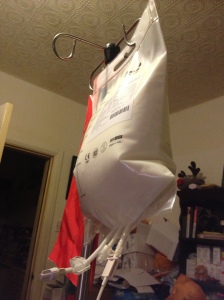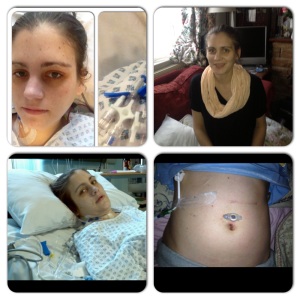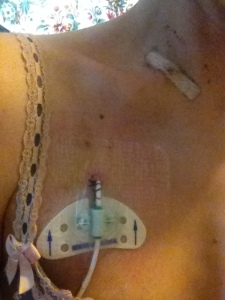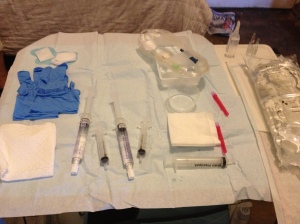August is Digestive Tract Paralysis awareness month and this week Is home artificial nutrition week here in the uk (I don’t know about anywhere else in the world.) So what better time to witter on a little about these ‘lovely’ subjects.
I’m going to start with Digestive tract paralysis as that’s where it all starts for me. Digestive tract paralysis is a group of conditions including and not limited too – gastropresis, achalasia, chronic intestinal pseudo obstruction, intestinal dysmotility, colonic inertia, hirschsprung disease, (There are sometimes different names used)
So you are probably (possibly) asking yourself “What the f**K is Digestive tract paralysis???” Well basically it means that one or more of the organs of the digestive tract stop functioning and become paralysed. Some people have one organ affected or as in my case it can effect the entire digestive tract. To help you understand better it will probably help a little if I bore you with a explanation of how our guts work, its actually pretty awesome if it works right!! (This is the science-y hopefully not too boring bit)
Our digestive system is made up of several organs, the main ones (that we are concerned with right now) are the oesophagus, stomach, small intestine and colon (large intestine). There job is too move food through the digestive process temporarily storing it along the way. Different elements of your nutritional needs are tabsorbed at different stages of the process and at the end the waste is excreted (don’t you just love that word!!), These organs are a complicated collection of sacks, tubes and valves that are made of muscle. This is a special kind of muscle called ‘smooth muscle’ or to give it its posh name ‘Visceral muscles‘ it is different from the muscle found on your skeleton, it has the form of thin layers or sheets which is made up of spindle shaped unstructured cells with single nuclei.
The organs of your digestive system function automatically – as in you don’t have to think about digesting that bacon sarnie (veggie and vegan bacon included!) you ate for breakfast, your body thankfully just does it so you can get on with enjoying life. Well when I say ‘just does it’ what I actually mean is that, your digestive system is also made up of an intrinsically complex network of nerves that is controlled be your autonomic nervous system, hormones and allsorts of incredibly beautifully complicated processes that you will be pleased to know i’m not going to bore you with (this time). The movement of food through the intestines is a special rhythmic pattern this process is called peristalsis, it is kind of like the heart beat of the digestive system. Electric signals from the nerves cause the muscle to contract in waves. If this pattern is disordered or not really there then food can not move through and then you are unfortunately in trouble.
So now we know what should be going on, you want to know why does this get so messed up?
That’s not really a simple question to answer, Digestive tract paralysis occurs when some part of the functioning screws up. This is usually because there is damage (disease related or exterior causes such as surgery) to the nerves or muscles of the digestive tract, or your autonomic nervous system doesn’t work right. There are many different underlying reasons that people have digestive tract paralysis. Sometimes you just never know and this is classed as idiopathic which means the cause is unknown.
So you may not know why your ill but you sure as hell know your ill. DTP can have a huge effect on your life. (HUGE!) Symptoms of DTP can range from mild and just niggly to severe and life threatening. Here are just some of the symptoms:
- nausea
- vomiting
- pain
- distention
- constipation
- diarrhoea
- Faecal impaction
- Bowel obstruction (mechanical)
- nutritional deficiencies
- malnutrition
- exhaustion
- electrolyte problems
- weight loss
- low weight
- swallowing problems
DTP can then lead to secondary problems, nutritional deficiencies are especially problematic. The list of secondary complications is pretty endless but here are a few
- anaemia
- hypoglycaemia
- osteoporosis
- poor wound healing
- cardiac problems (often caused by electrolyte imbalances)
- oesophageal tears
- teeth damage (nutritional and from vomiting)
- pain
- liver problems
- kidney problems
- aspiration
- weak immune system
Sucks right! well yeah it does, apart from the obvious struggle with all that fun I just listed there’s a huge extra difficulty on the social side. Life revolves around food. Think about the last few times you met up with friends, what you did over holidays, birthdays, evenings out. FOOD, FOOD, FOOD. Thankfully you get use being around food and being not able to eat it but it is another element to having DTP to consider.
So since its an illness then must be loads of treatments, even a cure??? hahahahahahahahahahahahahahahahahahahahaha I wish! Treatment and manageability of these conditions is very dependant on the severity, organ/s affected and underlying cause. There are currently NO CURES for DTP some people get some relief from medications such as pro-kinetics (pro-movement) or a gastric pacemaker. Many patients don’t. Some patients can manage on a regular diet, some a liquefied diet. But the a lot of patients need some form of artificial nutrition. This is usually delivered via a tube going to some part of the digestive system.
- NG TUBE (Nasogastric tube) – Tube that goes down the nose to the stomach.
- NJ TUBE(Nasojejanal tube) – similar to NG but goes down the nose bypassing the stomach to the jejunum (second part of the small intestine)
- G TUBE (Gastrostomy, PEG) – Usually endoscopically placed tube going through the abdominal wall directly in to the stomach.
- GJ TUBE – (Gastrojej, PEJ) – As Gtube but with a second port that goes to the jejunum.
- Jej Tube (jejunostomy) – surgically placed tube that goes through the abdominal wall directly in to the jejunum.
Some times the condition is to severe and the digestive system is to bad to tolerate any nutrition and some patients (like me) end up with intestinal failure. When this happens you have very little options left and as a final resort you have to have total parenteral nutrition (TPN). TPN is basically a concoction of sugars, fats, vitamins, electrolytes and minerals in a liquid solution that are specially formulated for each person. They are ‘fed’ in to the blood stream via a central venous catheter or ‘central line’ (hickman line, port or picc). A hickman line (which I have) is I thin tube that is tunnelled under the skin into a main artery where it rests in the right atrium about 3cm from the heart. The tpn solution is then pumped slowly, anything from 12 – 24hours a day into the blood stream to deliver a patients required nutrition. As it is delivered directly into the blood stream it means you don’t have to use the digestive system. Pretty Cool! well except the complications that come from tpn, theres your basic getting the nutrition and fluid levels right, blood sugar problems, to liver damage as the fats in TPN are toxic There is every TPNer’s biggest fear line infections, sepsis and septic shock. These are life-threatening complications requiring hospital admission potential line removal (operation to have it out and a new one in) lots of iv antibiotics, and most devastatingly sepsis can result in death. Having experienced all of these and also having lost a friend to a line infection the dangers are very real. Its a careful balancing act to get the benefits of tpn and negate the risk.
Many people on tpn live a full and active life, obviously a lot is also dependant on underlying condition.
Other things that are used to help people with DTP are anti sickness meds, pain meds, although if your a lucky one like me you struggle to absorb any meds to have to have as many of them in forms other than oral (yep that means a lot of injections and includes iv meds). Venting gastrostomys, so the peg tubes used to feed can also be used to drain the stomach to provide relief from vomiting. Some people have ostomys, do colon washouts, anal/rectal irrigation these are hit and miss if they work.
What about the future?
Where there is life, there is hope!
There is research being done, it tends to focus on the more common forms and causes of DTP such as diabetic gastroparesis and EDS which I unfortunately don’t fall into, but you never know what they’ll find. There are intestinal transplants/5 organ transplants as a last, last resort if tpn fails or you get liver failure due to tpn.. But the success rate and survival rate is relatively poor.
For me personally im probably on tpn for life and we’ll just continue to juggle and manage it with everything else we juggle and manage. I hope that Motility disorders and digestive tract paralysis are becoming more widely known about, that no child has to go through what I went through (Horrendous treatment, 13 years misdiagnosed as having an eating disorder and basically being left to suffer and nearly die a few times, read an overview here https://aprettylittletomboy.wordpress.com/2015/05/24/how-i-got-to-where-i-am-a-brief-overview ) That there is if not cure more treatments such as anti-sickness in more forms than just oral and iv and better pain management. More understanding of the condition. And more acceptance in the medical field that when they don’t know what’s going on or why something’s happening to not blame the patient and say there making it up just look outside the box. Our bodies haven’t read your medical textbooks not everything’s going to make sense that doesn’t make it not true, it should make it exciting for you. Its not going to be easy, but when you help that patient even just to give them a diagnosis you will change there life.
Anyways any questions feel free to ask, remember I am not a medical professional and thus non of this or what I say is medical advice. If your sick or worried about something talk to your drs or medical peeps. If they suck and make you feel sh*tt get new ones.but still talk about it. .
*j*

This is my lipid bag of tpn, I have 3500mls of tpn every night/day over 16 hours, I have 5 glucose bags and 2 lipid bags. I also do an extra 1000ml bag of dexsaline every day.



